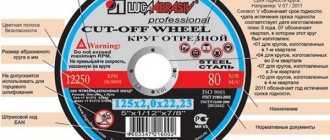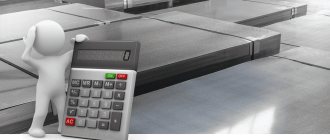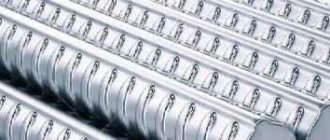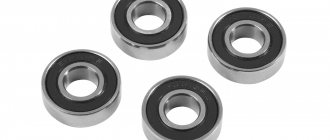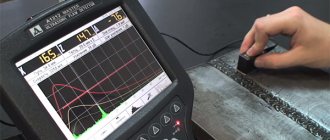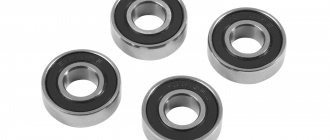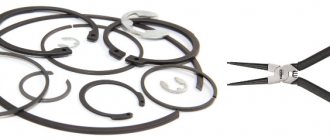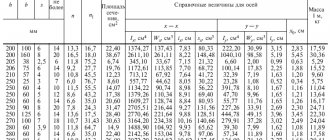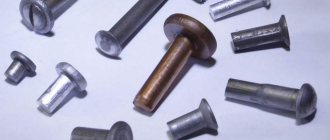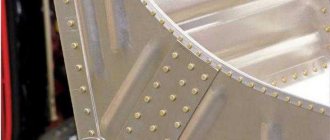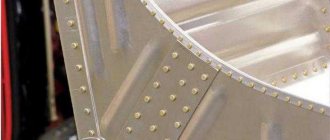Working with metal is not an easy task. Let's say you need to assemble a drainpipe from a bent stainless steel sheet. Use welding? High temperature deforms the workpiece. Take bolts and nuts? But what about the inside, you can’t really get into it.
For cases where there is access only from one side, a blind rivet is suitable: the dimensions of the hardware start from 2.4 × 6 mm, where 2.4 is the diameter and 6 is the length of the hollow tube.
Design
The fastener consists of two parts:
- Rod . At the end there is a thickening - a retainer for expanding the sleeve.
- Body . Consists of a head - a shoulder and a straight bushing.
Depending on the purpose, the head can be hidden. An ideal option when the hardware should be invisible on the surface of the material. Wide and high beads enhance the reliability of the connection, but are clearly visible to the naked eye. Not very aesthetically pleasing, but durable.
Peculiarities
Initially, it is worth recalling that until relatively recently, rivets were one of the most common types of hardware products. Today, despite the active introduction of advanced technologies and innovative technical solutions, the relevance of such fasteners remains in many modern areas. The design features and operating principle of threaded rivets deserve special attention.
It is important to consider that regardless of the variety, they work the same
At their core, all rivets are fasteners in the form of a sleeve with a folding head. On the other hand, there is a head that closes during the assembly process. If we compare the more familiar exhaust systems and the fastening devices under consideration, it will become clear that the latter differ, first of all, in the presence of a threaded element. In this case we are talking about a compact structure in the form of a sleeve (rod) having a cylindrical or hexagonal shape. Its upper part is equipped with a support side, and the lower part has a thread.
When considering the features of threaded rivets, it is necessary to pay special attention to the following clear advantages of this type of fastening devices
- Maximum ease of use.
- The strength of the connections created, including, if necessary, the installation of structures from fragile elements. This refers, for example, to thin sheet iron, even slight deformation of which during the assembly process is unacceptable.
- Possibility of high-quality unilateral fixation. This point is most relevant in situations where the total thickness of the parts being fastened exceeds the length of the hardware product. In this case, threaded rivets are able to ensure reliable installation without loss of performance characteristics of the structure.
- Maintaining fastening strength for a long time.
- Complete absence of chemical and mechanical aggressiveness.
- Preservation of the paint coating of the surfaces of the parts to be joined.
- Possibility of durable connection of structural elements made of different materials.
- Absence of any stresses of a mechanical nature.
- Possibility of repeated dismantling with re-installation of fasteners.
At the moment, preference is increasingly being given to welds, soldering or gluing. However, despite all the undeniable advantages of this type of connection, in some situations the only rational solution is the use of rivets with a threaded element. In addition to all of the above, it should be noted that such devices can withstand significant thermal loads.
Also, threaded rivets do not cause structural changes in the mounted parts, which cannot be said about welding. This point is very important when joining different materials. And do not forget that the described hardware products, if necessary, ensure the preservation of the mobility of structural elements.
Naturally, there are certain disadvantages of such rivets, which include the following important points.
- At the preparatory stage, it is necessary to carry out the most accurate markings and make holes of the appropriate diameters.
- In the vast majority of cases, there is no tightness of the seams created. In some situations, the solution may be to install rubber gaskets or gaskets made of other materials.
- The work is accompanied by quite noticeable noise.
size table
The technical characteristics of rivets are regulated by international standards. These are GOST R ISO 15973-2005 and DIN 7337 . Here is a table with typical sizes:
| Marking | L (body length), mm | d (hole diameter), mm | D (body diameter), mm |
| 2,4×6 | 6,00 | 2,50 | 2,40 |
| 2,4×8 | 8,00 | 2,50 | 2,40 |
| 2,4×10 | 10,00 | 2,50 | 2,40 |
| 2,4×12 | 12,00 | 2,50 | 2,40 |
| 3,2×6 | 5,80-6,60 | 3,30 | 3,20 |
| 3,2×8 | 7,80-8,60 | 3,30 | 3,20 |
| 3,2×10 | 9,80-10,60 | 3,30 | 3,20 |
| 3,2×12 | 11,80-12,60 | 3,30 | 3,20 |
| 3,2×14 | 13,80-14,60 | 3,30 | 3,20 |
| 3,2×15 | 15,00 | 3,30 | 3,20 |
| 3,2×16 | 15,80-16,60 | 3,30 | 3,20 |
| 3,2×18 | 17,80-18,60 | 3,30 | 3,20 |
| 3,2×21 | 21,00 | 3,30 | 3,20 |
| 3,2×25 | 25,00 | 3,30 | 3,20 |
| 4,0×6 | 5,80-6,60 | 4,10 | 4,00 |
| 4,0×8 | 7,80-8,60 | 4,10 | 4,00 |
| 4,0×10 | 9,80-10,60 | 4,10 | 4,00 |
| 4,0×12 | 11,80-12,60 | 4,10 | 4,00 |
| 4,0×14 | 13,80-14,60 | 4,10 | 4,00 |
| 4,0×16 | 15,80-16,60 | 4,10 | 4,00 |
| 4,0×18 | 17,80-18,20 | 4,10 | 4,00 |
| 4,0×21 | 21,00 | 4,10 | 4,00 |
| 4,0×25 | 25,00 | 4,10 | 4,00 |
| 4,8×6 | 5,80-6,60 | 4,90 | 4,80 |
| 4,8×8 | 7,80-8,60 | 4,90 | 4,80 |
| 4,8×10 | 9,80-10,60 | 4,90 | 4,80 |
| 4,8×12 | 11,80-12,60 | 4,90 | 4,80 |
| 4,8×14 | 13,80-14,60 | 4,90 | 4,80 |
| 4,8×16 | 15,80-16,20 | 4,90 | 4,80 |
| 4,8×18 | 17,80-18,20 | 4,90 | 4,80 |
| 4,8×20 | 20,00 | 4,90 | 4,80 |
| 4,8×21/22 | 20,80-21,20 | 4,90 | 4,80 |
| 4,8×24/25 | 24,80-25,70 | 4,90 | 4,80 |
| 4,8×27 | 27,00 | 4,90 | 4,80 |
| 4,8×30 | 30,00 | 4,90 | 4,80 |
| 4,8×32 | 32,00 | 4,90 | 4,80 |
| 4,8×35 | 35,00 | 4,90 | 4,80 |
| 6,4×10 | 10,00 | 6,50-6,70 | 6,40 |
| 6,4×12 | 12,00 | 6,50-6,70 | 6,40 |
| 6,4×14 | 14,00 | 6,50-6,70 | 6,40 |
| 6,4×16 | 16,00 | 6,50-6,70 | 6,40 |
| 6,4×18 | 18,00 | 6,50-6,70 | 6,40 |
| 6,4×21 | 21,00 | 6,50-6,70 | 6,40 |
| 6,4×24/25 | 25,00 | 6,50-6,70 | 6,40 |
| 6,4×28 | 28,00 | 6,50-6,70 | 6,40 |
The hole is drilled 0.1-0.2 mm wider than the diameter of the rivet. This makes it easier to insert the sleeve, plus it expands as the locking rod moves.
Overview of species
At the moment, in the corresponding segment of the modern hardware market there is a wide range of fastening devices under consideration. We produce rivet bolts, versions with cylindrical sides, blind and other threaded rivets. On the one hand, this allows you to select the most suitable rivets in each specific case, taking into account all current criteria. At the same time, such diversity causes certain difficulties in choosing.
First of all, we are talking about the material from which the rivets are made, the latter can be:
- steel;
- made from stainless steel;
- copper;
- made of aluminum alloy.
By type of thread
In this case we are not talking about devices with external threads. There are two options for designing rivets with internal threads.
- Nuts with threads from M4 to M8, designed for permanent connection. It is more advisable to install when there is no access to the back side of the parts.
- Screws with threads from M3 to M16, with the help of which a collapsible connection is created.
By head type
In addition to the material of manufacture and thread features, the described fastening devices are divided into types, taking into account the features of the head. There are two categories of models.
- With flat heads - used on small surfaces.
- With countersunk heads - installed when it is necessary to create minimally noticeable connections.
According to the profile of the leg
Taking into account this parameter, all commercially available fastening devices can be divided into the following three types.
- Smooth, which are recommended for use when it is necessary to connect structural elements made of soft and brittle materials.
- Corrugated - threaded rivets, designed to perform installation work related to fastening harder materials. This surface treatment allows you to minimize the possibility of turning the leg.
- Hexagonal - another category of products designed for durable materials. The profile in this case almost completely eliminates the possibility of turning the rivet during its installation and fixation.
By type of pile
Taking into account the features of this part of the hardware, it should be noted that there are rivets with the following types of collars
- Cylindrical.
- Secret.
- Reduced.
The choice in favor of models with a hidden or reduced collar is made if it is necessary to minimize the gap between the parts being connected. It is also necessary to remember several important points in the context of preparing parts and the nuances of performing installation work. In accordance with current rules and regulations, before installing any types of rivets, the mounting holes are always countersinked.
By purpose
Now on the market you can find almost any threaded rivets, including models for plastic, as well as those designed for use when installing a rivet gun. Taking into account the purpose, the following types of models can be distinguished:
- with increased electrical conductivity;
- with a force that allows for stretching or indentation;
- designed to create the most airtight connections;
- having heads of enlarged sizes;
- with inch thread;
- having special marks on the surface designed for quick visual identification;
- with high-quality and effective vibration isolation.
Thickness calculation
We have body length in the table. But is it so easy to choose hardware for joining materials? If we focus only on the values in the “L” column, we will make a mistake. After all, you need to take into account that when pulling the rod, the sleeve expands greatly at the end. This process takes away precious millimeters. Therefore there is a formula:
L1 = S + (1.2 × D)
Here L1 is the actual “useful” length, S is the sum of the thickness of the materials for the connection, D is the diameter of the body.
a plate with a similar indicator equal to 3 to iron 6 . Total 9
mm.
Logically, 2.4×10 (third line from the top in the table). But let's calculate using the formula:
L1 = 9 + (1.2 × 2.4) = 11.88 mm.
It turns out that you need a rivet, at least a 3.2×12 with a body length of 11.80-12.60 mm.
For convenience, we provide a selection table with ready-made calculations:
| Sleeve diameter, mm | Sleeve length, mm | Thickness of materials, mm | |||
| 2,4 | 4 | 0,5 — 2,0 | |||
| 6 | 2,0 — 4,0 | ||||
| 8 | 4,0 — 6,0 | ||||
| 10 | 6,0 — 8,0 | ||||
| 12 | 8,0 — 10,0 | ||||
| 3 | 4 | 0,5 — 1,5 | |||
| 5 | 0,5 — 2,5 | ||||
| 6 | 1,5 — 3,5 | ||||
| 7 | 1,5 — 4,5 | ||||
| 8 | 3,5 — 5,5 | ||||
| 10 | 5,5 — 7,0 | ||||
| 12 | 7,0 — 9,0 | ||||
| 14 | 9,0 — 11,0 | ||||
| 16 | 11,0 — 13,0 | ||||
| 18 | 13,0 — 15,0 | ||||
| 3,2 | 4 | 0,5 — 1,5 | |||
| 5 | 0,5 — 2,5 | ||||
| 6 | 1,5 — 3,5 | ||||
| 8 | 3,5 — 5,5 | ||||
| 10 | 5,5 — 7,0 | ||||
| 12 | 7,0 — 9,0 | ||||
| 15 | 9,0 — 12,0 | ||||
| 18 | 12,0 — 15,0 | ||||
| 20 | 15,0 — 17,0 | ||||
| 4 | 5 | 0,5 — 2,5 | |||
| 6 | 1,5 — 3,0 | ||||
| 7 | 3,0 — 4,5 | ||||
| 8 | 3,0 — 5,0 | ||||
| 10 | 5,0 — 6,5 | ||||
| 12 | 6,5 — 8,5 | ||||
| 14 | 8,5 — 10,5 | ||||
| 16 | 10,5 — 12,5 | ||||
| 18 | 12,5 — 14,5 | ||||
| 20 | 14,5 — 16,5 | ||||
| 25 | 16,5 — 21,5 | ||||
| 30 | 21,5 — 26,0 | ||||
| 4,8 | 6 | 0,5 — 3,0 | |||
| 8 | 3,0 — 4,5 | ||||
| 10 | 4,5 — 6,0 | ||||
| 12 | 6,0 — 8,0 | ||||
| 14 | 8,0 — 10,0 | ||||
| 16 | 10,0 — 12,0 | ||||
| 18 | 12,0 — 14,0 | ||||
| 21 | 14,0 — 17,0 | ||||
| 24 | 17,0 — 20,0 | ||||
| 27 | 20,0 — 23,0 | ||||
| 30 | 23,0 — 25,0 | ||||
| 32 | 25,0 — 27,0 | ||||
| 35 | 27,0 — 30,0 | ||||
| 40 | 30,0 — 35,0 | ||||
| 45 | 35,0 — 40,0 | ||||
| 50 | 40,0 — 45,0 | ||||
| 5 | 6 | 0,5 — 3,0 | |||
| 8 | 3,0 — 4,5 | ||||
| 10 | 4,5 — 6,0 | ||||
| 12 | 6,0 — 8,0 | ||||
| 14 | 8,0 — 10,0 | ||||
| 16 | 10,0 — 12,0 | ||||
| 18 | 12,0 — 14,0 | ||||
| 20 | 14,0 — 16,0 | ||||
| 25 | 16,0 — 21,0 | ||||
| 30 | 21,0 — 25,0 | ||||
| 35 | 25,0 — 30,0 | ||||
| 40 | 30,0 — 35,0 | ||||
| 45 | 35,0 — 40,0 | ||||
| 50 | 40,0 — 45,0 | ||||
| 6 | 8 | 2,0 — 4,0 | |||
| 10 | 4,0 — 6,0 | ||||
| 12 | 6,0 — 8,0 | ||||
| 14 | 8,0 — 10,0 | ||||
| 16 | 10,0 — 11,0 | ||||
| 18 | 11,0 — 13,0 | ||||
| 20 | 13,0 — 15,0 | ||||
| 25 | 15,0 — 20,0 | ||||
| 30 | 20,0 — 24,0 | ||||
| 35 | 24,0 — 29,0 | ||||
| 6,4 | 12 | 2,0 — 6,0 | |||
| 15 | 6,0 — 9,0 | ||||
| 18 | 9,0 — 12,0 | ||||
| 22 | 12,0 — 16,0 | ||||
| 26 | 16,0 — 20,0 | ||||
| 30 | 20,0 — 24,0 | ||||
| 35 | 24,0 — 29,0 | ||||
| 50 | 29,0 — 42,0 | ||||
Features of installation work
When you use mechanical special tools, significant physical effort will be required to obtain truly reliable connections of structural elements. The fact is that rivet nuts significantly counteract the tightening forces. A pneumatic riveter significantly simplifies the task , but its cost remains high.
If you have a special mechanical or pneumatic-hydraulic tool available, the installation process will be very simple:
- screwing the nuts directly onto the threaded rods in the riveter;
- the tool together with the hardware is turned until it stops in the hole made;
- the rod of the device is carefully pulled out, after which the fasteners are riveted independently;
- unscrewing the rod from ready-made connections.
Marking
If you look at the principle of operation of rivets with a broach, it becomes clear that the rod must be stronger than the sleeve, otherwise it will not be able to expand the edge. Therefore, in addition to the dimensions, the marking indicates the composition of the metals from which the hardware is made. The first value is the body, the second is the core:
- Al/St – aluminum and galvanized steel.
- Al/Al – aluminum and magnesium-aluminum.
- Al/A2 – aluminum and stainless steel.
- A2/A2 – stainless steel and more durable stainless steel.
- Cu/St – copper and galvanized steel.
- Cu/Br – copper and bronze.
- Cu/A2 – copper and stainless steel.
- St/St – galvanized steel of different strengths.
a 4 is indicated next to the composition designation . This will look like Cu/St 0000 .
Let’s take, for example, a product from a domestic manufacturer with the marking (picture in the subheading):
HARPOON A2/A2 3.0×10 Dk6.5 K0.8 F3.1-3.2 D3 L10 G5-6.5
The decryption will be like this:
- HARPOON is a brand.
- A2/A2 – made of stainless steel.
- 3.0×10 - sleeve diameter 3 mm, length 10 mm.
- Dk6.5 - side diameter 6.5 mm.
- K0.8 - side thickness 0.8 mm.
- F3.1-3.2 - hole diameter from 3.1 to 3.2 mm.
- D3 - body diameter 3 mm.
- L10 - body length 10 mm.
- G5-6.5 - the thickness of the materials being bonded is from 5 to 6.5 mm.
Product advantages
Essentially, threaded rivets are hybrids of traditional nuts. But they should not be confused with exhaust vents. They have advantages, including:
- ease of installation work;
- you can reliably connect components made from fragile materials or those that have insignificant thickness (rolled sheet metal), because the rivet nut will not lead to deformation;
- if the total thickness of the products exceeds the length of the fasteners, then a one-sided fixation is made, without a through passage, and the quality of work will not be low.
Types of threaded rivets
The range is quite wide, there are many classifications of fasteners. So, they can have a flat or countersunk head, a nut or screw thread, a round or hexagonal leg (does not allow rotation in the mounting sockets)
If you take into account the purpose, then there may be:
- electrically conductive;
- having increased force (possibly indentation or stretching);
- for highly hermetic connections;
- with enlarged heads;
- with inch thread application;
- with special marks (for visual identification);
- with vibration isolation.
Materials used for production
The fasteners in question may have different sides. To get regular connections, buy nuts that have standard flanges. If you need to get a slight gap between the parts, it is better to use hardware with reduced or hidden sides. It is worth considering that before installation begins, the procedure of countersinking the holes into which the rivets will be placed is performed.
Threaded rivet nuts can be produced from several types of metal, in particular:
- Carbon steel. For the production of universal products and the creation of standard connections.
- Made of stainless steel. Production of hardware that will be used at high temperatures or in places with high humidity levels.
- Made of aluminum. Such rivets are distinguished by their low weight and excellent anti-corrosion properties.
- Made of bronze. This metal is used if fasteners with low spark generation rates are needed.
